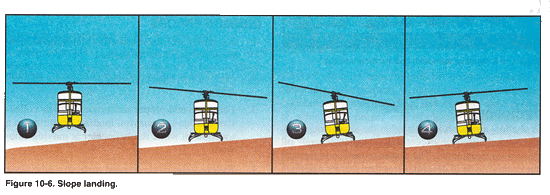CFI: Kristie H.
Aircraft: Robinson R22 Beta II
Aircraft ID: N8361N
Duration: 1.3hrs
Cumulative Time: 70.4hrs
Lots of practice again today. Focus on slope landings.
Here is how a slope landing is done:
Position the helicopter across the slope at a stabilized hover headed into the wind over the spot of intended landing (Frame 1). Downward pressure on the collective starts the helicopter descending. As the upslope skid or wheel touches the ground, hesitate momentarily in a level attitude, then apply lateral cyclic in the direction of the slope (Frame 2). This holds the skid against the slope while you continue lowering the downslope skid with the collective. As you lower collective, continue to move the cyclic towards the slope to maintain a fixed position (Frame 3). The slope must be shallow enough so you can hold the helicopter against it with the cyclic during the entire landing. A slope of 15 degrees is considered maximum for normal operation of most helicopters, However check the POH of the particular helicopter being flown for the manufacturer's recommended limitation.
You should be aware of any abnormal vibration or mast bumping, that signals maximum cyclic deflection. If this occurs, abandon the landing because the slope is too steep. In most helicopters with a counterclockwise rotor system, landings can be made on steeper slopes when you are holding the cyclic to the right. When landing on slopes using left cyclic, some cyclic input must be used to overcome translating tendancy. If wind is not a factor, you should consider the drifting tendancy when determining landing direction.
After the downslope skid is on the surface, reduce the collective to the full down position, and neutralize the cyclic and pedals (Frame 4). Normal operating RPM should be maintained until the full weight of the helicopter is on the landing gear. This ensures adequate RPM for immeadiate takeoff in case the helicopter starts sliding down the slope. Use antitorque pedals as necessary throughout the landing for heading control. Before reducing RPM, move the cyclic as necessary to check that the helicopter is firmly on the ground.
And a slope pickup is done:
Begin the takeoff by increasing RPM to the normal range with the collective full down. Then, move the cyclic towards the slope (Frame 1). Holding cyclic towards the slope causes the downslope skid or wheel to rise as you slowly raise the collective (Frame 2). as the skid or wheel comes up, move the cyclic towards the neutral position. If properly coordinated, the helicopter should attain a level atttude as the cyclic reaches the neutral position. At the same time, use antitorque pedal pressure to maintain heading and throttle to maintain RPM. With the helicopter level and cyclic centered, pause momentarily to verify everything is correct, and then gradually raise the collective to complete the liftoff (Frame 3).
After reaching a hover, take care not to avoid hitting the ground with the tail rotor. If an upslope wind exists, excute a crosswind takeoff and then make a turn into the wind after clearing the ground with the tail rotor.
Simple, huh. :)
1 comment:
Whoa. That's way too academic for an old guy like me. There is a lot of similarity to a hover in the initial stage of a slope landing -- you want to be stable with a skid touching and use the controls to maintain that attitude. As you lower collective, you'll need upslope cyclic. If you run out of cyclic then it's time to go back up (I have never heard of a mast bump in this maneuver, BTW).
Same with going up -- I treat it like coming to a hover with a skid touching. Then just neutralize the cyclic as you pull pitch, and be careful where you put the tail rotor!
I know ATP-rated pilots with a bizillion hours who have never done a slope landing in real life (you can generally find a flat spot to land!), and am convinced that the maneuver is taught for the purpose of learning better control of the ship. Nothing wrong with that :)
Post a Comment